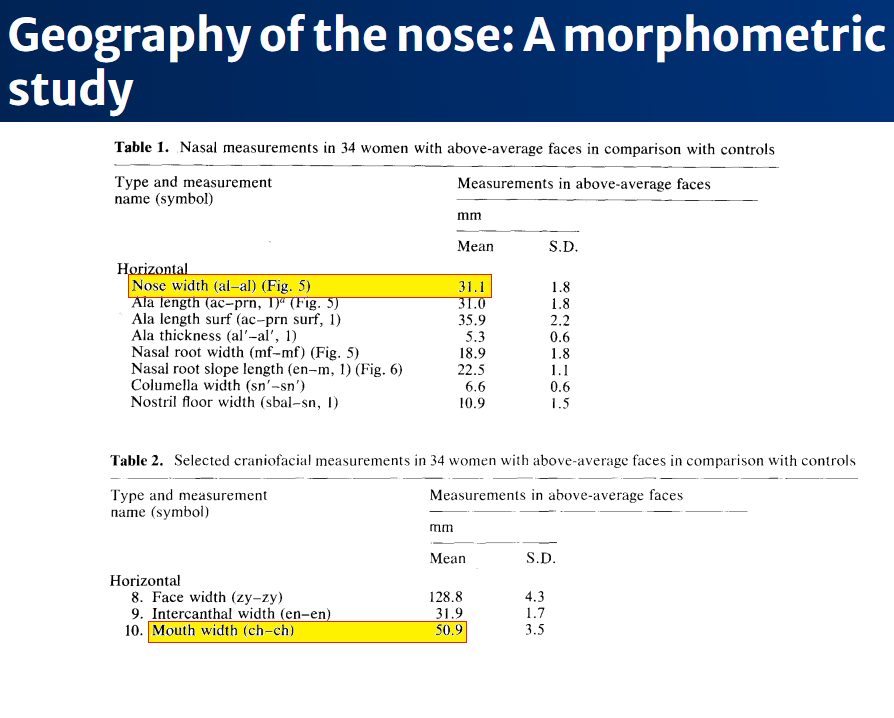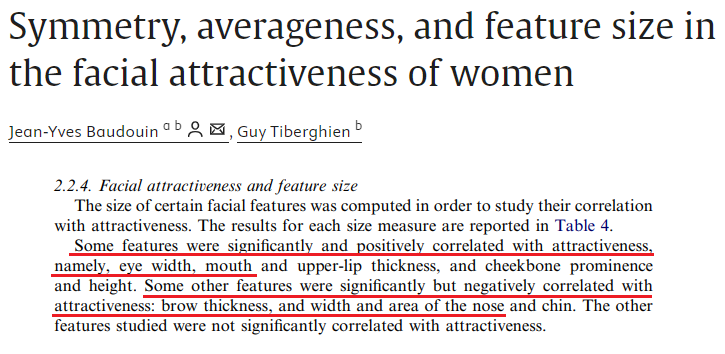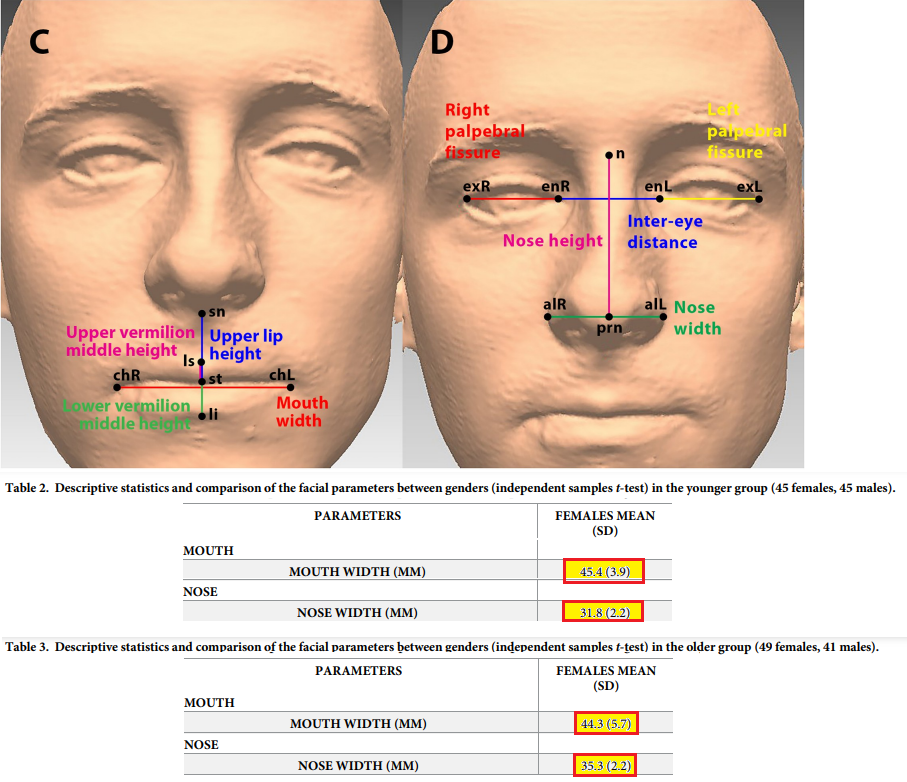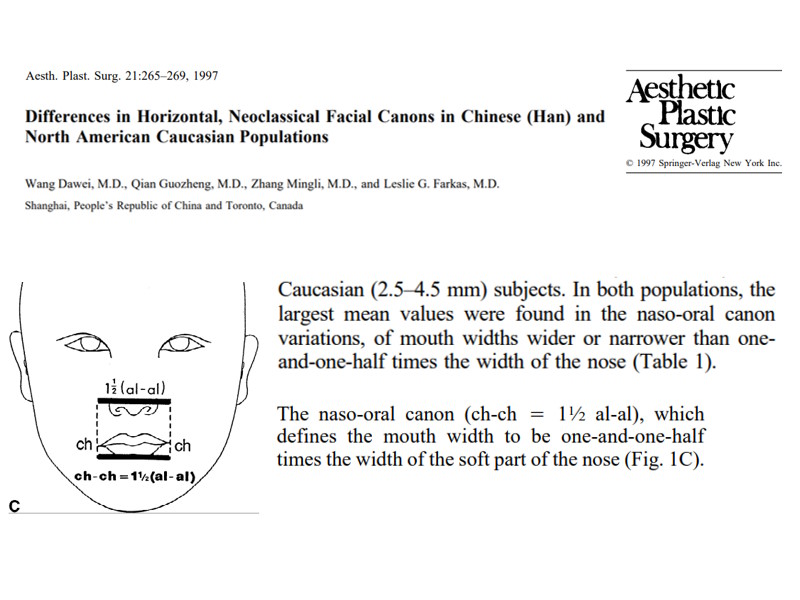Summary
The blog explores the significance of the mouth-to-nose width ratio in perceived female attractiveness. Several studies are discussed, including the “Differences in Horizontal, Neoclassical Facial Canons” study, which suggests that an ideal mouth width is approximately 1.5 times the nose width for enhanced attractiveness. Farkas et al.’s “Geography of the Nose” study found that attractive women typically had a nose-to-mouth width ratio of 1.64, emphasizing a narrower nose. Baudouin and Tiberghien’s research highlights that wider mouths and narrower noses are positively correlated with attractiveness, supporting the importance of this ratio. Additionally, Skomina et al.’s study indicates that younger women have a larger mouth-to-nose width ratio (1.43) compared to older women, further reinforcing the association between a larger ratio and youthful, feminine attractiveness.
Research
Studies suggest that the ratio between mouth width and nose width plays a significant role in determining a person’s perceived attractiveness. Specifically, research such as the study titled “Differences in horizontal, neoclassical facial canons in Chinese (Han) and North American Caucasian populations” has shed light on the ideal mouth-to-nose ratio. According to this study, it is generally considered more attractive for the mouth width to be approximately 1.5 times larger than the nose width. In other words, if the mouth is of a similar size or smaller than the nose, it may not be perceived as attractive. These findings provide valuable insights into the importance of the mouth-to-nose ratio when evaluating facial attractiveness.

In the study titled “Geography of the Nose: A Morphometric Study“ by Farkas et al. (1986), researchers analyzed the facial proportions of 34 attractive young North American Caucasian women. They found that most of these women (67.6%) had a narrower nose relative to their mouth width, with an average Nose Width of 31.1 mm and a Mouth Width of 50.9 mm. This results in a ratio of approximately 1.64. This proportion helps to create a visually pleasing and balanced facial appearance, highlighting the mouth and contributing to an overall attractive look.

In the study titled “Symmetry, Averageness, and Feature Size in the Facial Attractiveness of Women“ by Baudouin and Tiberghien (2004), the researchers explored how various facial features contribute to the perception of female attractiveness. They found that certain features including wider mouth are positively correlated with attractiveness, while nose width was negatively correlated. This suggests that a larger ratio of Mouth Width to Nose Width is perceived as attractive because it aligns with the desirable feature proportions identified in the study. This ratio likely contributes to a face that appears more symmetrical and closer to the “average,” both of which are key factors in what is considered attractive.

Another recent study by Skomina et al. (2020) suggests that certain facial dimensions, including mouth and nose width, are indicators of attractiveness. A larger Mouth Width to Nose Width ratio contributes to a more feminine and aesthetically pleasing facial structure. As per this study, the mean value of mouth width in females is 45.4 mm in younger women and 44.3 mm in older women. Whereas, the mean value of nose width in females is 31.8 mm in younger women and 35.3 mm in older women. For younger females, the ratio of Mouth Width to Nose Width is 1.43, while, for older females, the ratio is 1.26 suggesting that younger women generally have a larger mouth width to nose width ratio.

References
Dawei, W., Guozheng, Q., Mingli, Z., & Farkas, L. G. (1997). Differences in horizontal, neoclassical facial canons in Chinese (Han) and North American Caucasian populations. Aesthetic plastic surgery, 21(4), 265-269. https://link.springer.com/article/10.1007/s002669900123
Farkas, L. G., Kolar, J. C., & Munro, I. R. (1986). Geography of the nose: a morphometric study. Aesthetic plastic surgery, 10, 191-223. https://doi.org/10.1007/BF01575292
Baudouin, J. Y., & Tiberghien, G. (2004). Symmetry, averageness, and feature size in the facial attractiveness of women. Acta psychologica, 117(3), 313-332. https://doi.org/10.1016/j.actpsy.2004.07.002
Skomina, Z., Verdenik, M., & Hren, N. I. (2020). Effect of aging and body characteristics on facial sexual dimorphism in the Caucasian Population. PloS one, 15(5), e0231983. https://doi.org/10.1371/journal.pone.0231983
